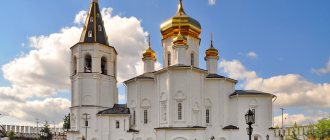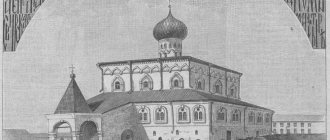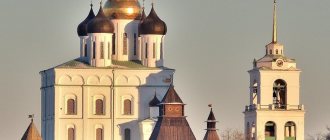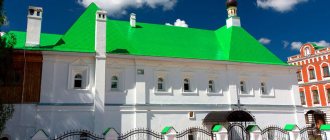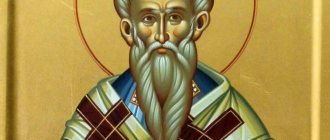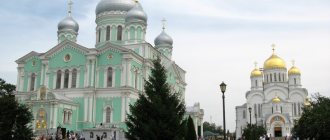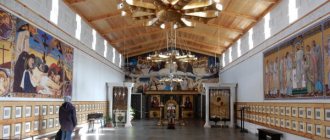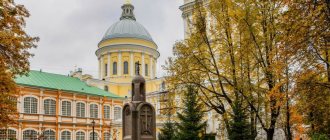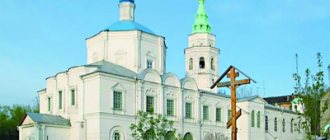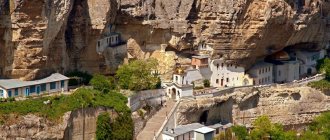In Murom there are two monasteries nearby: the male Holy Annunciation and the female Holy Trinity. The Holy Trinity Convent is famous for the fact that the relics of Saints Peter and Fevronia, patrons of love, fidelity and marriage, rest there.
Monument to Peter and Fevronia near the Annunciation Monastery
Current state and activities of the parish
The Holy Trinity Monastery conducts active educational activities. In addition to the Nadezhda boarding house, which provides support to pupils from disadvantaged families aged 4 to 16 years who are receiving secondary education here, the monastery is in charge of several prisons, a military unit, a colony for minors and the Murom community of disabled people “Phoenix”.
On a note! There are three temples here. A healing spring was opened in honor of the Murom miracle workers Peter and Fevronia.
Fevronya
And no one could cure him, the best doctors came to him from all over, but it was all in vain. If in the village of Laskovo, Ryazan land, there had not been a young healer Fevronya, who undertook to treat the prince, but set her own conditions: that he would take her as his wife if she healed him. At first the prince did not take this seriously. And, having been healed the first time, he did not come for her, but then he was again covered with fetid scabs. And then he took Fevronya as his wife.
By that time, his older brother Pavel had died, and Peter began to rule Murom. But the boyars did not like his commoner wife; their wives did not want to obey her. And they decided to expel her. Her pious husband also left Murom behind her. The boyars fought for power for a long time, but without choosing a worthy one, they came and tearfully asked Peter and Fevronya to return to the throne.
The pious couple ruled fairly and wisely, and when the couple grew old, they took monastic vows and together began to pray that God would send them death on the same day and hour. For this they even prepared one large coffin with a partition.
But the clergy did not listen to them, and their bodies were twice left overnight in different churches, and the next morning they were found together in the same coffin. Therefore, it was decided to bury them together. This story will forever remain in the hearts of those who at least once hear or read it, because the holy wonderworkers Peter and Fevronya still help many, you just have to have very strong faith in them and in God.
Shrines
The Vilna Cross is considered one of the most ancient shrines of the monastery. In 1657, when Russian troops came to the city of Vilna (present-day Vilnius), a certain Arzamas resident Vasily Mikulin found this cross. The find was kept by Mikulin for a long time. But one day he heard a voice from heaven, which ordered him to take the reliquary cross to the Holy Trinity Monastery. After the loss of the shrine, the management of the city museum in 1996, on May 15, again transferred the Vilna Cross to the monastery.
Important! The Trinity Monastery is famous for the fact that the relics of the holy couple, Peter and Fevronia, rest within its walls. The prince and princess are considered the patrons of marriage and family ties. Therefore, numerous pilgrims flock here, hoping for the intercession of the saints.
Holy Trinity Monastery
Video:
Basic moments
Holy Trinity Cathedral
The Trinity Convent is located in the historical center of Murom, on the left bank of the Oka. Tradition connects this part of the city with a medieval fort and the first Christian temple, built by Prince Gleb of the Rurik dynasty at the beginning of the 12th century. The churches, bell tower and other buildings of the monastery were well preserved; during the process of many years of restoration, the buildings were restored to their authentic appearance. The landscape is complemented by the golden-domed temples of other ancient monasteries built nearby.
Rare decorative elements have been preserved in the decoration of the facades of the buildings of the Holy Trinity Monastery - glazed ceramic tiles with relief images. Notable are the elegant forged crosses decorating the domes of the Trinity Cathedral, the gate church and the bell tower. They were created by Murom craftsmen more than 380 years ago. The main cathedral of the Trinity Monastery houses the remains of the legendary couple who ruled Murom in the 13th century - Prince Peter and the kind-hearted princess-healer Fevronia. The nuns still follow the traditions of mercy: the monastery has opened a shelter for elderly disabled people and orphans.
History of the Holy Trinity Monastery
In 1642, Murom philanthropist Tarasy Tsvetnov donated a large sum for the construction of a new church in the city in the name of the Holy Trinity. The inscription of gratitude on the foundation stone in the basement of the building reminds us of this. The five-domed brick cathedral was erected on the site of the dismantled log Boris and Gleb Church, which had stood on the banks of the Oka since the times of the Grand Dukes. Soon the Holy Trinity Convent arose near the walls of the cathedral, and construction continued. The Kazan Gate Church appeared above the entrance, and to the west of it in 1652 a three-tier bell tower with an octagonal hipped roof rose. All the buildings of the monastery are made in the same architectural style of Russian patterns.
In 1663, Moscow Tsar Alexei Mikhailovich granted the Trinity Monastery several surrounding villages and extensive land plots. Freed from taxes by the royal charter, the monastery flourished in subsequent centuries. The decree of Empress Catherine II on secularization did not affect the Holy Trinity Monastery, but only increased the number of its nuns. Nuns were transferred here from three abolished convents in the Murom district.
In 1805, there was a fire in the Holy Trinity Monastery. Several cell buildings and outbuildings were damaged, and a wooden fence burned down. During the restoration work, the monastery was surrounded by a beautiful brick wall with decorative battlements and corner turrets. During the 19th century, the territory was decorated with several chapels and two-story cells. A school for illiterate women was built behind the monastery wall. By the beginning of the 20th century, 140 students attended her classes.
After the October Revolution of 1917, the monastery was closed. For several decades, apartments, workshops, and warehouses were housed in solid cell buildings. Only in the 70s of the last century the complex of monastery buildings was recognized as a historical and architectural monument. The residents were resettled and restorers began work. During this period, the ensemble was supplemented by the wooden church of Sergei of Radonezh, transported from the ancient village of Pyangus. The temple was built in 1715.
In May 1991, monastic service was resumed at the Holy Trinity Monastery. Icons, liturgical utensils, and also a shrine containing the remains of Saints Peter and Fevronia were transferred from the local museum to the churches. According to church tradition, the legendary couple died on the same day - June 25, 1228. In 2012, a bronze monument to Peter and Fevronia by the famous Moscow sculptor Vladimir Surovtsev was unveiled in a birch grove at the entrance to the monastery.
Walk through the monastery
The front Holy Gate leading to the Holy Trinity Monastery faces southeast. A gate temple in the name of the icon of the Kazan Mother of God was built above them. A little to the left, a tented bell tower rises above a whitewashed brick wall. Its upper tier rests on graceful columns, creating the impression that the high roof is floating in the air.
It would seem that the architects of the 17th century put all their skills into the rich decor of the bell tower. But in the Holy Trinity Monastery there is a structure that surpasses the belfry in the abundance of decorative elements. This is the magnificent Trinity Cathedral, whose facades are a kind of stone encyclopedia of the entire diversity of the architectural palette of Russian patterns.
Nowadays you can see that the 5 metal domes of the Trinity Cathedral are painted with a modest gray paint. Only the central dome is decorated with gold stars. But from the description of 1766 it is known that initially the domes were covered with mottled green tiles that sparkled brightly in the sun. The domes were rebuilt after a fire that engulfed the cathedral at the beginning of the 19th century. However, the chapters are crowned with forged gilded crosses, preserved in the fire, created by Murom blacksmiths in the middle of the 17th century. The top of the highest cross, which is above the central dome, is decorated with a skillfully forged silhouette of a sailing ship. This is probably an allusion to the merchant activity of the founder of the Holy Trinity Cathedral, Tarasy Tsvetnov, who delivered goods to Murom along the Oka River.
On the whitewashed facade of the temple, cornices highlight a pediment decorated with two rows of rectangular tiles with dark green glaze. On the ceramic tiles you can see relief plant patterns, images of armed horsemen, double-headed eagles, and mythical animals. Window kokoshniks and altar apses are decorated with tiles.
Holy Trinity Convent in MuromThe main shrine of the ancient cathedral is the tomb of the faithful Peter and Fevronia. The silver Vilna Cross, brought in the 17th century from the city of Vilna (modern Vilnius), is also especially revered. The cavities of the cross-casket contain pieces of the relics of 35 Christian saints. By the way, the curious history of this relic was written down by the same Tarasy Tsvetnov who built the cathedral. In his declining years, the benefactor took monastic vows at the Annunciation Monastery, located in Murom.
In front of the southern façade of the cathedral there is a small monastery churchyard. On the right is a miniature pond surrounded by an orchard. On the left hand there is a building with the apartments of the abbess. The nuns of the monastery live in two-story cell buildings attached to the fence.
A refectory was erected in the eastern part of the territory of the Holy Trinity Monastery. Opposite is the log church of St. Sergius of Radonezh, built even before the founding of the monastery in one of the surrounding villages. In the 1970s, restorers dismantled the ancient temple and moved it here. In 2000, a chapel with an altar of Saints Peter and Fevronia was built near the utility yard. Pilgrims light a funeral candle on the altar and draw blessed water from the spring. They say that girls who prayed here to Saint Febronia will soon find their betrothed. There is a church shop nearby where you can buy commemorative crosses, icons, and Christian literature.
Part of the monastery territory is fenced off; emergency construction work is underway here. In April 2022, a long segment of the eastern wall collapsed. This section of the fence was in need of repair for a long time: the ground under the foundations of 1807 subsided from groundwater and the wall tilted dangerously. To restore the fence, it was decided to use the same old brick, having previously cleaned it of lime mortar. The work will be completed in 2022.
Practical information
The gates of the Trinity Monastery are open to visitors from 06:30 in the morning, at which time the liturgy begins. Tourist access ends at the end of evening prayers.
A stone's throw from the Holy Trinity Monastery there are two more monasteries - Annunciation and Resurrection. To the south lies the Oksky Park, from where you can go to the river embankment. Here you can have a snack at the El Caramelo cafe. Nearby there is a historical and art museum and several historical estates. Behind the park you can see the domes of the churches of the Spasskaya Monastery, which is also worth visiting.
How to get there
The most convenient way for tourists to get from Moscow to Murom is from the Kazansky railway station by long-distance trains stopping in this city. Early train 072G “Moscow – Cheboksary” departs at 04:56 and arrives at Murom-1 station in 4 hours 46 minutes. Tickets will cost from 602 to 1399 rubles. During the day, other passing trains depart from the same station, heading to Yoshkar-Ola, Chelyabinsk, Ulan-Ude, Cheboksary, Kazan, Barnaul.
Buses run from the Shchelkovsky bus station to Murom twice a day. The journey will take just over 7 hours, the ticket price is 965 rubles.
Moscow motorists should take the M7 highway leading east, through Balashikha and Noginsk. Behind Koloksha, in front of Vladimir, follow the signs and turn onto the P72 highway. Having reached the center of Murom, head along Moskovskaya Street, it will lead to your destination. The total distance by road is 310 km, the trip will take approximately 5 hours 30 minutes. Address of the Trinity Monastery in Murom: Peasant Square, 3-A.
Patronal holidays and honored dates
In the Holy Trinity Monastery, the feast of the Holy Trinity, celebrated on June 3, is considered patronal.
The following days are also especially revered:
- Appearance of the Kazan Icon of the Mother of God - July 8;
- Day of the Icon of the Mother of God “Kazan” - October 22;
- Day of Remembrance of the Blessed Princes Peter and Fevronia, the Murom miracle workers - June 25;
- Finding of the relics of St. Sergius of Radonezh - July 5;
- The repose of St. Sergius of Radonezh is September 25.
Wooden church in honor of St. Sergius of Radonezh on the territory of the monastery
Iveron Icon of the Virgin Mary
Another shrine is located in this temple of the Holy Annunciation Monastery: the miraculous Iveron Icon of the Mother of God.
This amazing miraculous icon is located in the central cathedral of the Spaso-Annunciation Monastery. It is located in the very right part of the temple near the window, next to the right altar.
This image is a copy of the Athos Icon of the Mother of God, glorified in the Christian world, as well as a copy of the Iveron Icon, which was given to the monastery in 1812.
An icon of stunning beauty and strength! Under the glass hangs a lot of gold and silver jewelry that people donated to the Mother of God as a token of gratitude for the quick and miraculous hearing of prayers.
Next to the Iveron Icon there is an image of Elijah of Murom with a particle of his relics. This icon was presented to the Annunciation Monastery by the monks of the Kiev Pechersk Lavra, where the holy relics of the epic Russian Bogatyr are located in the caves.
